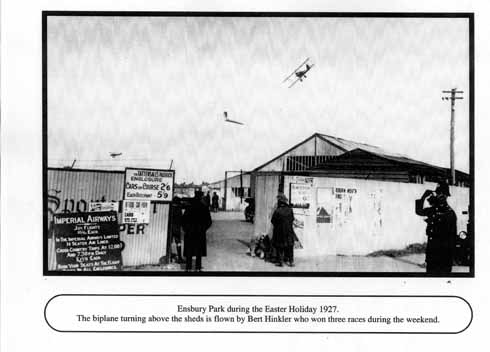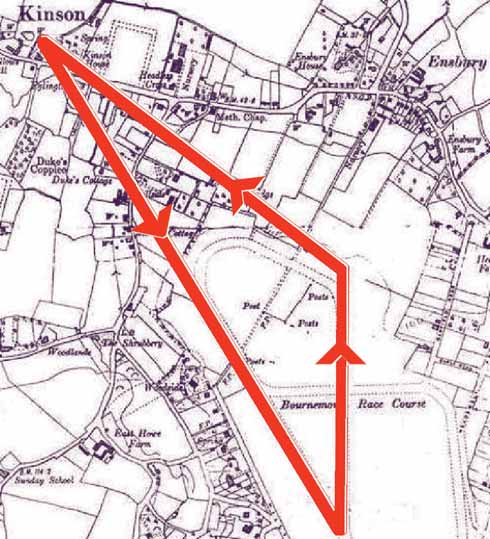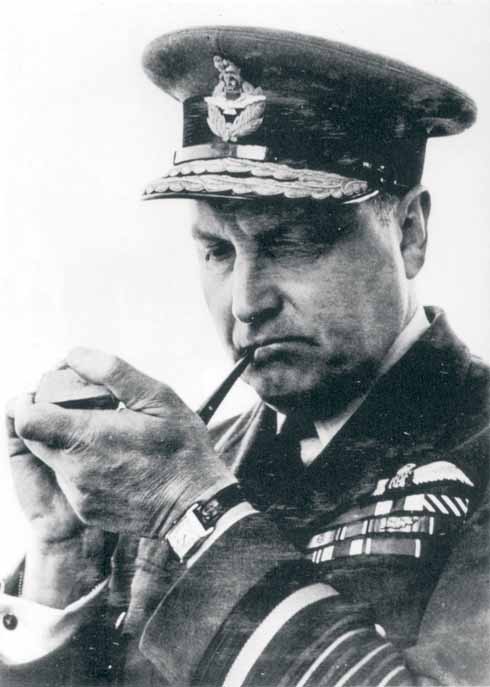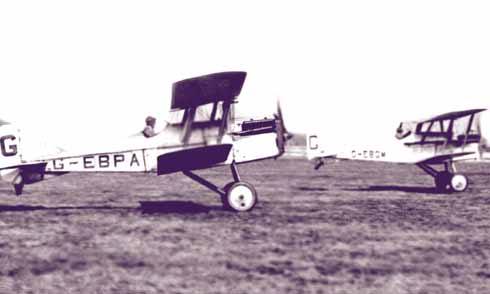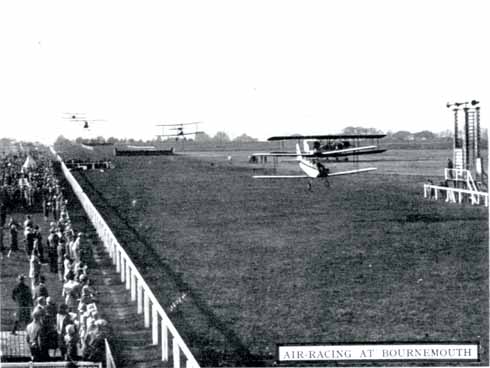Aces Low – Bournemouth’s flying races
Lorraine Gibson charts the extraordinary story of Bournemouth’s flying races
Published in September ’13
Today Bournemouth has impressive aviation credentials. Its airport enjoys international status, its air festival attracts large crowds, and its residents live in relative harmony with the associated airborne comings and goings; ’twas not ever thus.
Turn back the clock to just over a century ago, when manned flight was in its infancy, and it was a town seething with controversy over the proposal of a Yorkshireman called Frederick Etches to create a racecourse and aerodrome complex in Kinson. Uproar at his intention to race planes at high speed over houses was further fuelled by the fact that he planned to stage some of these ‘spectaculars’ on Sundays. The local clergy were not amused and fire and brimstone sermons on the evils of unbridled frivolity and, worse, of gambling on the Lord’s Day thundered from many a pulpit. Also up in arms was the council, raising objections and attempting to block any plans associated with the scheme. And as for the locals, while many relished the potential thrill of horses thundering on the ground and flying machines whizzing overhead, yet more feared it would be irritating, detrimental to their properties and downright dangerous.
Etches, who lived at Edgehill Road in Winton and was a pioneering pilot with his own Monsanto-G aircraft, had harboured ambitions of the aviatory kind for the town as far back as 1915, when he leased a couple of fields on what is now Bournemouth University’s campus on Wallisdown Road, opposite Talbot Village. Here he set up the Bournemouth Aviation Company, a flying school which trained pilots prior to entry into the Royal Flying Corps, later to become the RAF. From here he also masterminded the first plane landing in Poole to raise funds for Poole Soldiers’ Home and Cornelia Hospital, a haven for war casualties named after its benefactress, Lady Cornelia Spencer-Churchill, wife of Ivor Bertie Guest, 1st Baron Wimborne, and aunt of Winston.
The historic flight left Wallisdown, piloted by the school’s chief instructor, and landed in a field next to Poole Park four-and-a-half minutes later. In reply to a query over the cost of the exercise, a peeved Etches replied: ‘What? Don’t you think we can render a little service for two noble causes in the most important town in the country in which our flying school is situated?’
His school thrived, with some of the world’s leading lights in aviation, including Sir Alan Cobham, going through their paces there, until in 1917 it transferred to an 88-acre site at Ensbury Park, roughly covering the area around Hillview Road and Redhill Drive. Pilots continued to be schooled there and it was requisitioned by the Royal Flying Corps; when the Royal Air Force was formed in 1918 it became RAF Winton. Airmen were trained in the emerging art of aerial warfare and introduced to new communication devices at the on-site RAF Wireless Telephony School.
During this period, the perils of early flight were highlighted by more than a few ‘prangs.’ One highly-decorated pilot took off and circled low to wave to his girlfriend below. His plane hit a tree and he was killed. Another, Second Lieutenant Edward Rebbeck, son of a former Bournemouth mayor, was killed when his aircraft plunged to the ground, and a biplane barely missed crashing into Bournemouth town centre after suffering engine failure as it looped over the Square.
In 1919 the RAF moved out and the aerodrome became civilian, an event marked with an inaugural flight by an ex-RFC Handley Page bomber (0/400 D8350) with one of the war’s legendary fighter pilots , Lt Col William Sholto Douglas, at the controls. Douglas was famous for his fierce dog-fights with the enemy, including an intense plane-to-plane battle with Hermann Goering over France. He was in Bournemouth in his role of a Handley Page test pilot but would later rejoin the RAF, rising to head of Fighter Command shortly after the Battle of Britain.
So, while action in the skies was a familiar sight in Bournemouth, the town remained divided over Etches’ flying circus-cum-racetrack plans. Undeterred, he acquired the RAF site and finally found support and funding for the stadium, which lay roughly where Leybourne Avenue sits now. Air services were established and occasional air shows were staged. In the early 1920s the racecourse with two grandstands and stabling for 100 horses was finally built by McAlpine at a cost of about £100,000. Suddenly Fred Etches was manager of the Ensbury Park Racecourse Company and the first horse-race meeting in 1925 was a runaway success, attracting a crowd of 12,000 on the opening day.
The Ensbury Park course was owned by Etches along with a syndicate of entrepreneurs, one of whom was Sir Henry John ‘Jock’ Delves Broughton, after whom Broughton Avenue is named. A controversial figure, he was subsequently tried for murder in Happy Valley, Kenya in 1941. It was alleged that the baronet shot dead the Earl of Erroll, who had been having an affair with Brougton’s wife. Broughton was acquitted through lack of evidence and a dispute over the gun used. In the film White Mischief, based on the story, Broughton was played by Joss Ackland.
For a while, race meetings at the two-mile, figure-of-eight course became the place to be seen and it was tipped to become ‘the Ascot of the South’, but an overwhelming lack of enthusiasm for betting, combined with high ticket and transport prices, resulted in the horse-racing lasting just eleven months. Etches wasn’t fazed. He had always intended the place to be an arena for showcasing the era’s flight developments and, despite continued protests from the churchmen, the first public air-race meeting was held in August 1926, with townsfolk witnessing for the first time aircraft tearing at high speed along a course marked by pylons. It was foolhardy by today’s standards, but these were the heady embryonic days of flight and nothing could stop the daredevil pilots.
The initial meeting, the ‘Bournemouth Summer Aviation Race’, took place over the August bank holiday weekend. Entry to each of the eight events cost ten shillings, with prize money topping £100 for the main event, the Bournemouth Summer Handicap. There were races with turning points over Kinson Farm and Parley Green and it was not the magnificent men in their flying machines but a local farmer who stole the headlines on the historic first day. His name was Trelawney Reed and he was so incensed by the infernal contraptions buzzing over his land and unsettling his herd, not to mention his poorly mother, that he let off both barrels of his shotgun at a low-flying biplane, narrowly missing the pilot, who was on his honeymoon.
Reed was arrested and taken to court, where he told the magistrate that the planes flew so low they took the heads off his red-hot pokers. Reed was supported in court by his friend, the celebrated artist Augustus John, who lived a few miles away at Alderney Manor. His testimony obviously held some weight as the farmer was found not guilty and discharged. The Bournemouth Times & Directory correspondent opined that, ‘Whilst shooting at planes is to be deprecated…any vulgar-minded aeronaut is now suffered to fly his noisy, menacing machine over the town.’ It may have had nothing to do with the noise and the menace, but a short time later Augustus John moved to Fordingbridge.

Major L P Openshaw's Westland Widgeon passes in front of the Ensbury Park grandstand, just moments before he was fatally injured crashing into another plane on 6 June 1927
Not surprisingly, the races brought a string of accidents and while Reed’s shotgun failed to take down the maverick airman on that particular show day, the dangers of racing planes were brought home during the third meeting, at Whitsun 1927, an event that was to be the swansong of racing in the town. It began badly on the first morning of 4 June when a DH37, G-EBDO, piloted by Major H Hemming, hit the scoreboard on take-off and crashed into the enclosures. The pilot was severely injured and the passenger, Mr St John-Plevins, died. Astonishingly, the event went ahead, but there was more tragedy to come on 6 June when two planes collided near West Parley, killing both pilots. Ironically, one was the same pilot who had been previously shot at by Trelawney Reed.
This meeting was the largest of its kind ever to have been held in Britain, but the tragedies spelled the end for Ensbury Park Racecourse Ltd and it went into liquidation the following year. By 1930 all racing – plane, horse or otherwise – had ended and within two years much of the land was a housing development; new roads built included Leybourne Road and Western Avenue, upon which the main grandstand had once proudly stood. The last part of the old racecourse was built over near Gillam Road and a new road was created. Its name? Etches Close.
